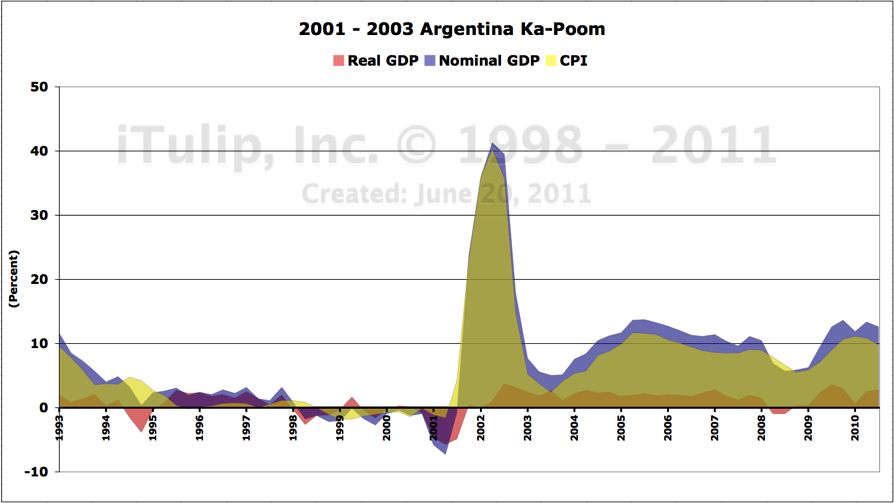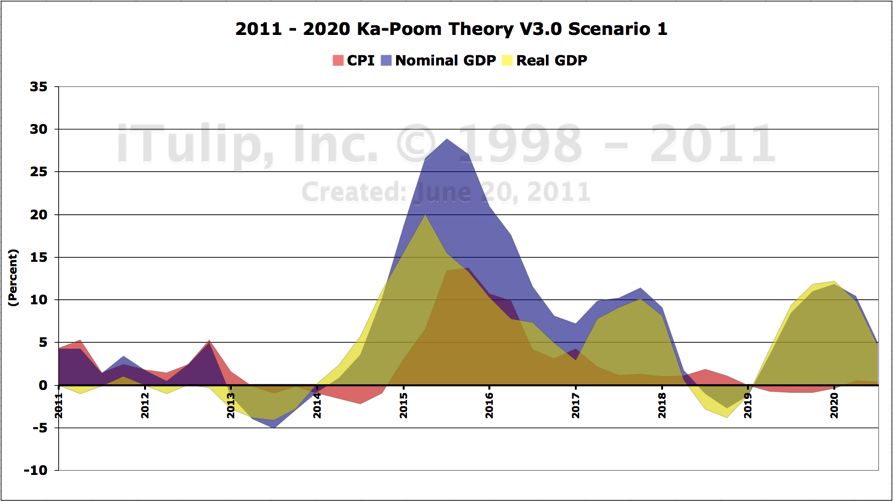iTulip.com
notes
Basic theory: An epochal shift in the gold market started in 2001 and
has continued, with periods of volatility, at more or less the same
trend rate ever since. My theory since 2001 is that the rising gold
price trend traces the gradual dissolution of the US$ Treasury system
punctuated by crisis and temporary resolution. It will eventually end
with a Sudden Stop crisis that I have since 1999 called Ka-Poom Theory,
possibly mitigated by a re-opening of the gold window. The Argentina
peso bond market crisis of 2001 and 2002 confirms the Ka-Poom Theory
which is comprised of two phases, a deflationary phase driven by capital
flight and an inflationary phase that results from a currency depreciation.
See Argentina's Ka-Poom graph below.

See also, (VIDEO)
Argentina's Economic Collapse. A U.S. version of the Ka-Poom
theory, still a work in progress, is mapped below.

Notes from: The
Next Ten Years--Part II. Over the coming two years (2011-2013),
expect to see the economy continue to grow moderately in nominally between
2% and 3%, while it continues to shrink in real terms. However, at some
point interest rates will begin to rise in response to inflation, even
as the output gap continues to put a deflationary bias on consumer prices
and wages. That will tend to open the gap even wider, as borrowing costs
rise.
The recession of 2012-2013 will be created by the withdrawal of fiscal
stimulus by the majority Republican 111th Congress. Under conditions
of debt deflation, if stimulus is withdrawn before an output gap was
closed, recession recurs. This second recession will open the output
gap to 6% of GDP. The first recession was from 2007 to 2009. That recession
opened the output gap to 4% of GDP. The monetary stimulus of dollar
devaluation against oil plus the fiscal stimulus of the Bush and Obama
administrations, together these measures closed the output gap from
4% to 2% of GDP between 2009 and 2011.
A recession event in 2012-2013 suggests only one policy option -- monetary
inflation -- but several scenarios for achieving it with sufficient
political cover to prevent foreign creditors from bolting. The output
gap is likely to grow to 8% by 2014. At that point, inflation becomes
the only option. We will continue to use public funds to grow the money
supply as private sector borrowing remains too weak to do so and monetary
policy is now ineffectual. For the next several years, the US will continue
to claw its way through the output gap by moving private debt to public
account as Japan has since 1992 until either the US runs out of public
credit or an external global geopolitical event occurs that has the
effect of producing a large spike of inflation.
Three factors will influence our investment decisions over the next
ten years.
- China's finance and export based state capitalist system will enter
a severe crisis in 2012-2013 as its property bubble collapses.
- The Euro will not end. The eurozone will shrink as weaker debtor
economies such as Greece are jettisoned and creditors consolidate
economic and political power.
- The world will have three reserve currencies by the end of the decade:
the dollar, the euro, and the yuan representing American, European,
and Asian trade blocks.
2011 to 2020 Uncertainty Era Asset Allocation Rulebook
Rule #1: As long as the US economy remains in an output gap trap,
the fiscal position will worsen. When the housing bubble collapsed the
US fell into the output gap trap that consigns the US to ever-growing
fiscal deficits, at least until the US runs out of public credit. If
the US attempts the Japanese method of managing the output gap via fiscal
stimulus at the same rate starting in 2000, the US public debt will
reach 140% by 2015.
Rule #2: As long as the US fiscal position worsens, the dollar
will weaken. The US cannot grow its public debt to 195% or 140% of GDP,
and likely not even 100%, because of the US economy's dependence on
imported capital and its gross external debt position. Invariably, for
a net debtor, a fiscal deficit puts pressure on the currency.
Rule #3: Periods of high energy costs are periods of poor economic
growth and stock market performance. The time to be in the stock market
is when inflation is on a falling trend, as it was from 1980 to the
year 2000. The worst time to be in stocks is at the beginning of a period
of rising inflation. The Argentina peso bond market crisis of 2001 and
2002 confirms the Ka-Poom Theory which is comprised of two phases, a
deflationary phase driven by capital flight and an inflationary phase
that results from a currency depreciation. See here.
A new administration will some day place the blame for the crisis on
the previous administration and take no responsibility for the hardship
that their decisions are about to visit upon us.
Rule #4: If the US fails to exit its output gap before the next
recession, the US will experience a bond and currency crisis several
years thereafter, as soon as after the 2012 presidential election or
as late as the 2016 presidential election. See here
for a US version of the event, still a work in progress.
Summary
The 1980 to 2007 credit bubble was an existential economic error akin
to the 1920 to 1929 credit bubble. The credit bubble entered its first
crisis in 2000. The Greenspan housing bubble was a credit-financed New
Deal (akin to the 1930s) that rescued the economy in 2002. The next
stock market correction will be driven by the pricing-in of the mid-gap
recession (which may have begun in August, 2011). The 2008 to 2009 financial
crisis and economic recession was the first phase of the process of
debt deflation following the multi-decade credit bubble.
We are out of private credit needed to finance a next bubble. Within
a few years we will be out of public credit needed to move private debt
to public account to manage a persistent output gap, debt deflation,
and Peak Cheap Oil all at once. Europe's, China's, and US sovereign
crises will occur in rapid series over a period of months perhaps starting
as soon as 2H 2012. Sovereign credit games in Europe, China, and the
US will end in a cascade of sovereign debt defaults and a currency markets
crisis that will eventually be resolved through the development of three
currency blocks, American, European, and Asian by 2020.
Social relations among competing interest groups will escalate. Governments
will respond to escalating domestic unrest with increasingly repressive
surveillance and control. The primary investment challenge of the next
ten years is economic and political uncertainty.
We will experience the greatest economic and social uncertainty
in 100 years over the next ten.
Notes from: Illusion
of Recovery; Global Panic into Gold--Part II.
The key thesis of Ka-Poom Theory is that the US will experience a debt
and currency crisis if US creditor countries run into economic and political
difficulties at home that lead them to calculate that they are better
off focusing on domestic policy matters rather than applying resources
to support the US in a bid to maintain the US as a viable export market.
Two ways The Deal (i.e. the arrangement of foreign investment in the
US in exchange for US demand for exports) is off. One, the US cannot
provide sufficient demand for Asian and European exports. Two, the US
in its effort to reflate debt rather than take politically painful steps
to write it off depreciates the dollar too far, too fast, exporting
inflation abroad. As the US demand engine sputters and inflation rises
world wide, foreign investment in the US dries up. This appears to have
started in Q1 2010.
The rate of foreign purchases of all US securities, of which Treasury
bonds are by far the largest part, began to decline in early 2010. Think
of it as the slow stop before the sudden stop. Net purchases turned
negative in June 2011, the last month reported. I do not think the correction
we saw in the stock market starting in July was coincidental. If the
trend since early 2010 continued in July and August and then into September,
and is joined by sales of US stocks, we may see a good old fashioned
autumn stock market crash.
The US$ Treasury based global monetary system began to break down in
2001. Since then, the process of breakdown has gone through several
stages. When central banks became net buyers in Q1 2009 the breakdown
entered a new stage. The reason for the price spike this summer could
be as simple as rumors of new central bank purchases on the heels of
purchases by the central banks of South Korea and Thailand. More likely
a new major buyer has emerged, one that reveals a significant political
shift in the system. The list of possible suspects is large and includes
Japan at the top of the list. I expect many similar parabolic rises
and corrections before the US$ Treasury epoch ends, as speculation about
shifting alliances among players drive gold prices.
- The parabolic rise of the gold/10-Year Treasury bond yield ratio
this summer backs up the notion that a new stage of the breakdown
has started.
- The tumultuous recent history of currencies priced in gold is driving
more and more governments to switch sides, reduce US$ Treasury bond
reserve holdings and increase gold holdings.
- Gold purchases and sales by government and international banking
institutions since Q1 2000 entered a new phase in Q1 2009. Rumors
of new entrants and shifting alliances will drive gold price volatility
for the duration of the epoch, and generally up.
The trend in the decline in the exchange rate value of currencies priced
in gold is ten years old, and the severe decline is five years old.
The trend of government net gold buying is two years old. The trend
in the decline in US Treasury bond purchases is 18 months old.


